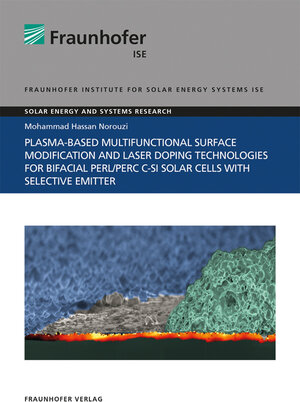Plasma-Based Multifunctional Surface Modification and Laser Doping Technologies for Bifacial PERL/PERC c-Si Solar Cells with Selective Emitter
von Mohammad Hassan NorouziLowly doped emitters are of particular interest for obtaining a low emitter saturation current density J0, e. However, the formation of screen printing contacts on the front side gets challenging with decreasing surface doping concentration, especially due to increased metal-induced recombination losses. In recent years, industrial solar cells featuring selective emitter has drawn a lot of attention since they offer both lowly doped areas between the front side contacts and local highly doped areas under these contacts. Considering the locally doped areas at the rear side of the cells, an attractive upgrade for PERC structure was introduced already in 1990 as passivated emitter and rear locally diffused (PERL) cells with a very high energy conversion efficiency of 24.7%. Moreover, to reduce the levelized cost of electricity, bifacial solar cells with metal grid patterns on both sides, can be a great lever. The industrial fabrication of such solar cells, nevertheless, is still challenging due to local processing and alignment steps which require relatively high production costs and complexity. To enhance the cell efficiency of bifacial PERL or PERC cells with selective emitter while decreasing the challenges and complexities of processing sequences, the PassDop approach is implemented in this work as a lean fabrication process by using doped passivation layers in combination with a laser process.






